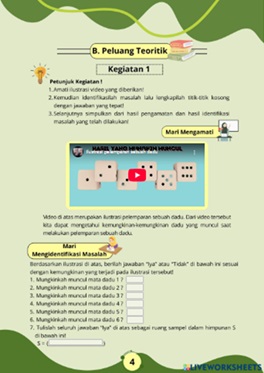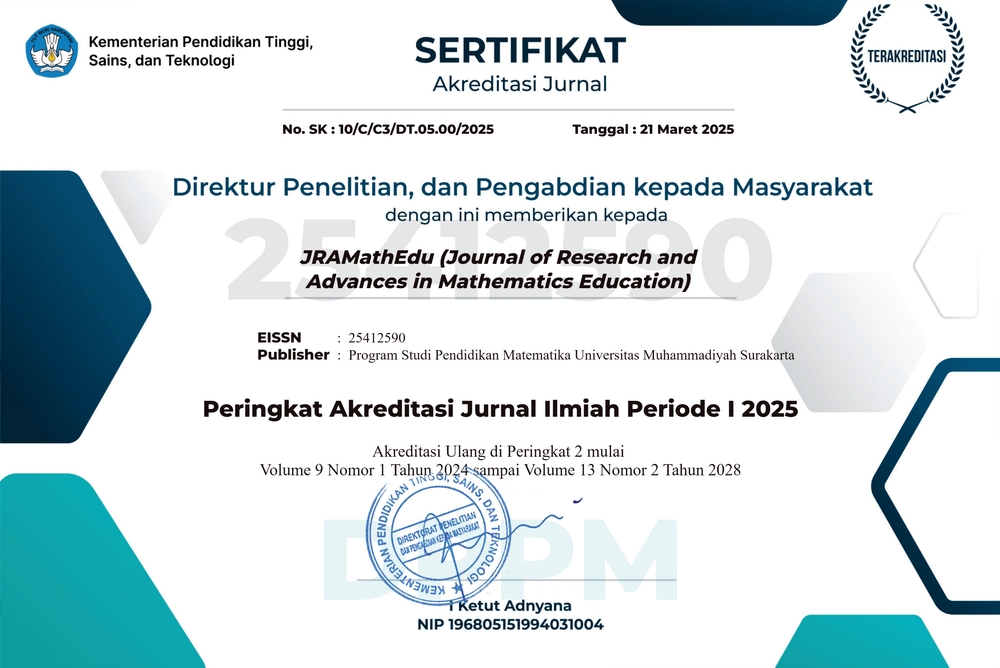Integrating liveworksheets for multirepresentational probability learning: A study on design validity and instructional effectiveness.
DOI:
https://doi.org/10.23917/jramathedu.v9i2.10399Keywords:
E-worksheet multirepresentation, Interactive digital media, Liveworksheets platform, Mathematical representation skills, Probability instructionAbstract
Mathematical representation is essential for students’ understanding, especially in probability which requires visual symbolic and verbal interpretation. However many digital worksheets lack integration across these modes. This study aimed to develop and evaluate a multirepresentational electronic worksheet using the Liveworksheets platform to enhance students’ representational skills in probability. The study applied the ADDIE development model which included curriculum analysis expert validation and classroom implementation through a pretest and posttest design. The worksheet combined interactive charts symbolic equations and explanatory prompts into a unified learning experience. Panels of experts consisting of subject-matter specialists media experts and psychometricians validated the content usability and alignment with educational objectives. Students who participated in pilot activities responded positively and reported high levels of engagement. The pretest and posttest results demonstrated improvements in students’ visual symbolic and verbal representation skills. These outcomes indicate that integrating multiple representation modes into a digital learning tool can effectively support deeper conceptual understanding. The study concludes that the developed worksheet is educationally valid engaging for learners and practical for classroom use. It offers a promising approach to support differentiated instruction in mathematics and enrich students’ learning experiences particularly in mastering abstract probability concepts.
References
Adie, L., Stobart, G., & Cumming, J. (2020). The construction of the teacher as expert assessor. Asia-Pacific Journal of Teacher Education, 48(4), 436–453. https://doi.org/10.1080/1359866X.2019.1633623
Barana, A., Marchisio, M., & Sacchet, M. (2021). Interactive Feedback for Learning Mathematics in a Digital Learning Environment. Education Sciences, 11(6), Article 6. https://doi.org/10.3390/educsci11060279
Cirneanu, A.-L., & Moldoveanu, C.-E. (2024). Use of Digital Technology in Integrated Mathematics Education. Applied System Innovation, 7(4), Article 4. https://doi.org/10.3390/asi7040066
Delgado-Rebolledo, R., & Zakaryan, D. (2020). Relationships Between the Knowledge of Practices in Mathematics and the Pedagogical Content Knowledge of a Mathematics Lecturer. International Journal of Science and Mathematics Education, 18(3), 567–587. https://doi.org/10.1007/s10763-019-09977-0
Effendi, K. N. S., Fadilah, S. R., & Imami, A. I. (2024). The Development of Interactive Student Worksheets Using the Liveworksheets Site on Middle School. 3052(1). Scopus. https://doi.org/10.1063/5.0200981
Erath, K., Ingram, J., Moschkovich, J., & Prediger, S. (2021). Designing and enacting instruction that enhances language for mathematics learning: A review of the state of development and research. ZDM – Mathematics Education, 53(2), 245–262. https://doi.org/10.1007/s11858-020-01213-2
Esen, S., Gecer, S., & Cetin, H. (2023). 5E Learning Cycle Supported Mathematics Digital Worksheets in Primary Schools: A Case Study. https://doi.org/10.15390/EB.2023.11645
Evans, R., & Cleghorn, A. (2022). Do student teachers see what learners see? – Avoiding instructional dissonance when designing worksheets. South African Journal of Childhood Education, 12(1). https://doi.org/10.4102/sajce.v12i1.1015
Fries, L., Son, J. Y., Givvin, K. B., & Stigler, J. W. (2021). Practicing Connections: A Framework to Guide Instructional Design for Developing Understanding in Complex Domains. Educational Psychology Review, 33(2), 739–762. https://doi.org/10.1007/s10648-020-09561-x
Ginting, D., Sabudu, D., Barella, Y., Madkur, A., Woods, R., & Sari, M. K. (2024). Student-centered learning in the digital age: In-class adaptive instruction and best practices. International Journal of Evaluation and Research in Education (IJERE), 13(3), Article 3. https://doi.org/10.11591/ijere.v13i3.27497
Ingram, J., Abbott, A., Smith, K., Planas, N., & Erath, K. (2024). Experienced teachers talking about their mathematics teaching with linguistically disadvantaged learners. Journal of Mathematics Teacher Education, 27(5), 785–808. https://doi.org/10.1007/s10857-024-09628-4
Jannati, A. A. & Sumardi. (2023). A minimum competency assessment-based electronic worksheets to improve mathematical literacy skills. 2886(1). Scopus. https://doi.org/10.1063/5.0155906
Kalyuga, S., & Singh, A.-M. (2016). Rethinking the Boundaries of Cognitive Load Theory in Complex Learning. Educational Psychology Review, 28(4), 831–852. https://doi.org/10.1007/s10648-015-9352-0
Kyriazis, A., Psycharis, S., & Korres, K. (2009). Discovery Learning and the Computational Experiment in Higher Mathematics and Science Education: A combined approach. International Journal of Emerging Technologies in Learning, 4(4), 25–34. Scopus. https://doi.org/10.3991/ijet.v4i4.1044
McCrudden, M. T., Kulikowich, J. M., Lyu, B., & Huynh, L. (2022). Promoting integration and learning from multiple complementary texts. Journal of Educational Psychology, 114(8), 1832–1843. https://doi.org/10.1037/edu0000746
Nathan, M. J., Srisurichan, R., Walkington, C., Wolfgram, M., Williams, C., & Alibali, M. W. (2013). Building Cohesion Across Representations: A Mechanism for STEM Integration. Journal of Engineering Education, 102(1), 77–116. https://doi.org/10.1002/jee.20000
Paivio, A. (1991). Dual coding theory: Retrospect and current status. Canadian Journal of Psychology/Revue Canadienne de Psychologie, 45(3), 255. https://doi.org/10.1037/h0084295
Paivio, A. (2013). Imagery and verbal processes. Psychology Press. https://www.taylorfrancis.com/books/mono/10.4324/9781315798868/imagery-verbal-processes-paivio
Pang, Y., Shan, A., Wang, Z., Wang, M., Li, J., Zhang, J., Huang, T., & Liu, C. (2022). Sparse-Dyn: Sparse dynamic graph multirepresentation learning via event-based sparse temporal attention network. International Journal of Intelligent Systems, 37(11), 8770–8789. Scopus. https://doi.org/10.1002/int.22967
Prasetia, E., & Sugiyarto, S. (2023). Development of an E-Worksheet Scientific Approach to Enhance Critical Thinking of 8th Grade Students. International Journal on Emerging Mathematics Education, 65–74. https://doi.org/10.12928/ijeme.v7i2.29580
Rudenko, N., Palamar, S., Nezhyva, L., Bondarenko, G., & Shyrokov, D. (2021). The Use of ICT Tools to Organize Distance Learning of Mathematics for Primary School Students under COVID-19 Pandemic Conditions. 3013, 371–380.
Sadeghi, M., & Armanfard, N. (2024). Deep Multirepresentation Learning for Data Clustering. IEEE Transactions on Neural Networks and Learning Systems, 35(11), 15675–15686. Scopus. https://doi.org/10.1109/TNNLS.2023.3289158
Setiawati, N. P., Darmawijoyo, & Hartono, Y. (2021). Learning Mathematical Modelling: How to design visual-formed Student’s Worksheet Using Traditional Food Context. 186–191. https://doi.org/10.2991/assehr.k.210508.063
Sweller, J. (2011). Cognitive load theory. In Psychology of learning and motivation (Vol. 55, pp. 37–76). Elsevier. https://www.sciencedirect.com/science/article/pii/B9780123876911000028
Zorzos, M., & Avgerinos, E. (2023). Research on visualization in probability problem solving. Eurasia Journal of Mathematics, Science and Technology Education, 19(4), em2247. https://doi.org/10.29333/ejmste/13066

Submitted
Accepted
Published
How to Cite
Issue
Section
License
Copyright (c) 2024 Santi Widyawati, Fredi Ganda Putra, Mutiara Fitria Bekti

This work is licensed under a Creative Commons Attribution-NonCommercial 4.0 International License.


















